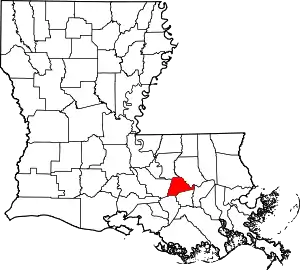Brittany, Louisiana
Brittany is an unincorporated community in Ascension Parish, Louisiana, United States.[1]
History
The community of Brittany was originally called “The Burn.” Around 1907 that LR&N railroad was built and a flag stop was made in this community. A year or so after a post office was established and it became necessary to choose a name for it. George W. Rice was the first postmaster. According to Mrs. W. J. Sevario, “he asked my mother, Mrs. S. S. Ferguson, to suggest a name. My mother suggested ‘Brittany’ and it was chosen. As far as I can remember she chose it because she liked the sound of it and it was uncommon.” (The Brittany post office was established on February 5, 1908, and is still operating.)
Around the time the post office was established, a small sawmill called “Hopper’s” was built in the 5th ward (Ascension Parish), and a spur line from the railroad to the mill was laid to haul logs and lumber to and from the mill. Later, Sidney St. Amant built a small sawmill near the J. De Haas. None of these mills are in existence anymore. The only industry now is the Alexander Step Factory at the side of the old Hopper sawmill.
There was an elementary school built on land donated by J. H. Dyer and from timber donated by people in the community. This was at first a one-room school. Later another room was added. The school continued for twenty or twenty-five years. Most of the children now go to the Gonzales school but some go to St. Amant.
At present there are no churches in Brittany. For a number of years there was a Latter-Day Saints (Mormon) Church, its members now attend services at a chapel near Gonzales. The majority of the inhabitants are Baptist or Catholic. There are about two or three hundred residents now.
Some of the early settlers were Joseph Richardson, Charles G. Fridge, John Paxton, S. S. Ferguson, William Hearst, W. W. Hodgson, Aidy Hudson, Joseph Brignac, Eugene Causey, J. J. Gonzales, Mike and Jim Savario, George W. Rice, Ernest Ford, E. Clouatre, and Rene Bercegeay.
There are now gravel or black-topped roads. For many years after the roads were established, they were nearly impossible during a rainy season.[2]
References
- U.S. Geological Survey Geographic Names Information System: Brittany, Louisiana
- Leeper, Clare; D’Artois (2012). Louisiana Place Names: Popular, Unusual, and Forgotten Stories of Towns, Cities, Plantations, and Even Some Cemeteries. Louisiana: Louisiana State University Press. p. 46. ISBN 978-0-8071-4738-2.
